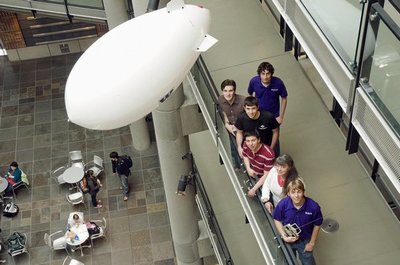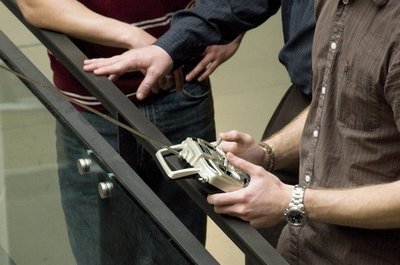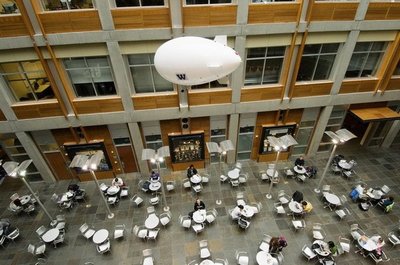June 3, 2010
Student-built blimp finds unique job in Computer Science Building
It started innocently enough, with a forwarded news article. Cindy Bush, scholarship coordinator for the UW’s College of Engineering, e-mailed it to her Engineering Emerging Leaders students as a joke: Undergraduates at the Massachusetts Institute of Technology had built a weather balloon that could take pictures from space.
Their reaction wasn’t quite what she’d expected.
“The funny thing is the UW has been doing this for the last several years in the atmospheric sciences department,” recalls John Thomson, a senior in electrical engineering. “But because it’s not students that have been taking the initiative, it’s not that big a deal.”
“We thought, ‘Why don’t we do something that’s student-led and that’s interesting, and then publish our parts and procedures online.'”
Thomson, a longtime remote-controlled airplane fan, settled on a blimp.
“A lot of people build airplanes. Not many people build blimps,” Thomson said. (He acknowledges that the Hindenburg disaster may be partly to blame.)
He recruited some engineering classmates to help. They approached the College of Engineering and the local chapter of the Institute for Electrical and Electronics Engineers for sponsorship. Thomson and his compatriots began researching the project online, and Bush helped them order a vinyl envelope and various electronics parts.
The Emerging Leaders in Engineering program is a scholarship that includes other activities. Students participate in various networking and outreach projects throughout the year, and part of their mission is to increase the interest and awareness of engineering on campus. Other Emerging Leaders have undertaken engineering projects, but nothing on this scale.
“It’s just taken on a life of its own,” Bush said.
The blimp’s maiden voyage was in April for the UW’s Engineering Discovery Days. The money had been raised. The parts were ready and waiting in the basement of Loew Hall. All that was left was to build it.
“The date kind of snuck up on us a bit,” Thomson admits. A few weeks before the event, “We said ‘OK guys. We’ve got to build this–now. So we had a few late nights down in the leadership office, hot-gluing things together.”
The students made their deadline and the blimp was a hit, floating over thousands of elementary and middle-school students who attended the Discovery Days.
“People were trying to teach the kids things and they would look up and go ‘Whoa, a blimp!’ and they would gravitate toward it,” said team member Whitney James.
The blimp flew again in Kane Hall, at a spring meeting of the IEEE’s Seattle chapter and at a UW McNair Scholars luncheon.
At a fourth flight, on campus last week, the students first filled the 7.5-foot blimp with helium then added enough pocket change to make sure it was neutrally buoyant, meaning it is essentially a refrigerator-sized weightless object. They then walked the blimp from its home in Loew Hall to the six-story atrium of the Allen Center.
Team members launched the blimp from the third-floor balcony and it hovered over students studying for final exams.
Remote controls operate two fans at the bottom of the blimp that direct the aircraft’s flight. Despite their small size, those fans, called vectored thrusters, have powerful motors.
“It’s pretty much the sports car of indoor blimps,” Thomson said.
On this occasion the founding team members were training students who will take over the project next year.
“Never go full throttle,” advised one experienced operator.
“Never go a quarter throttle,” said another.
The Department of Computer Science & Engineering allowed the blimp to fly in its building, but for a price.
“They’ve been challenged by CSE to get the paper airplanes off the window ledges,” Bush said. “They get thrown up there and it just drives people crazy.”
To catch the airplanes team member Andrew Reusch glued a piece of flexible balsa wood to the front of the blimp, making it look a bit like a flying narwhal. After many failed attempts, in which the blimp rammed into the window by a graduate student working at a computer, it finally hit its mark, and knocked a dusty paper airplane from its ledge.
Cheers erupted from the third-floor balcony.
Someone suggested that the team members might be able to get a job after graduation removing paper airplanes from the Allen Center. Ramses Alcaide, who will attend the University of Michigan next year for a combined M.D. and Ph.D. with a focus on neural prosthetics, said he will stick with his original career plan.
Thomson also graduates this year; appropriately enough, he will start a job this summer at Bellevue-based EagleTree Systems designing telemetry systems for remote-controlled planes.
Next year’s team hopes to make the control system more reliable so the blimp can fly outdoors.
“Our ultimate goal is to have it flying at Husky Stadium,” Thomson said.





